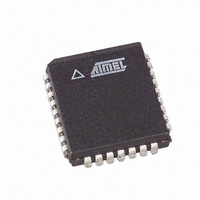AT49LH002-33JC Atmel, AT49LH002-33JC Datasheet - Page 23

AT49LH002-33JC
Manufacturer Part Number
AT49LH002-33JC
Description
IC FLASH 2MBIT 33MHZ 32PLCC
Manufacturer
Atmel
Datasheet
1.AT49LH002-33JC.pdf
(36 pages)
Specifications of AT49LH002-33JC
Format - Memory
FLASH
Memory Type
FLASH
Memory Size
2M (256K x 8)
Speed
33MHz
Interface
Parallel
Voltage - Supply
3 V ~ 3.6 V
Operating Temperature
0°C ~ 85°C
Package / Case
32-PLCC
Lead Free Status / RoHS Status
Contains lead / RoHS non-compliant
Available stocks
Company
Part Number
Manufacturer
Quantity
Price
AT49LH002
READ ARRAY: Upon initial device power-up and after exit from reset, the device defaults to
the read array mode. This operation is also initiated by writing the Read Array command. The
device remains enabled for reads until another command is written to the device.
Once the internal write state machine (WSM) has started a sector erase or program operation,
the device will not recognize the Read Array command until the operation is completed.
SECTOR ERASE: Before a byte can be programmed into a sector, the sector must first be
erased. The memory array is organized into multiple sectors that can be individually erased
using two different sector erase commands, Sector Erase and Uniform Sector Erase. The Uni-
form Sector Erase command can be used to erase the main sectors, and it can also be used to
erase all of the sub-sectors to allow the memory array to be erased in uniform 64-Kbyte
regions. The Sector Erase command is used to erase the individual sub-sectors to provide a
more efficient and finer erase granularity. In addition, the Sector Erase command can be used
to erase the main sectors as well to allow a single erase command to be used to erase any
sector in the memory array. Both sector erase commands require two command cycles to ini-
tiate the internally self-timed erase operation.
After issuing a sector erase command, the device’s Status Register may be checked to deter-
mine the status of the WSM and the erase operation. If the device detects a sector erase error,
the Status Register should be cleared before the system software attempts any corrective
actions. After a sector erase, the CUI remains in the Read Status Register mode until a new
command is issued.
Successful sector erase requires that the corresponding sector’s Write-Lock bit be cleared and
the corresponding hardware write protect pin (TBL or WP) be inactive. If using the Uniform
Sector Erase command to erase all of the sub-sectors, then all of the sub-sectors must have
their Write-Lock bits cleared and the TBL pin must be inactive. If a sector erase is attempted
when the sector is locked, the sector erase will fail, and the reason for the failure will be indi-
cated in the Status Register.
The erased state of the memory bits is a logical “1” (erased state of a byte is FFH).
BYTE PROGRAM: The device is programmed on a byte-by-byte basis. The Byte Program
command requires two command cycles with the programming address and data being input
on the second command cycle. The device will automatically generate the required internal
programming pulses, and all programming operations are completely self-timed. Please note
that the byte location being programmed must have already been erased to FFH. A “0” cannot
be programmed back to a “1”; only an erase operation can convert “0”s to “1”s.
After the Byte Program command is written, the device’s Status Register may be checked to
determine the WSM status and the result of the program operation. If a program error is
detected, the Status Register should be cleared before any corrective action is taken by the
system software. After a byte program operation, the CUI remains in the Read Status Register
mode until a new command is issued.
A successful program operation also requires that the corresponding sector’s Write-Lock bit
be cleared, and the corresponding hardware write protect pin (TBL or WP) be inactive. If a pro-
gram operation is attempted when the sector is locked, the operation will fail, and the reason
for the failure will be indicated in the Status Register.
READ STATUS REGISTER: The Status Register (SR) may be read to determine when a sec-
tor erase or program operation completes and whether the operation completed successfully.
The Status Register may be read at any time by writing the Read Status Register command.
After writing the Read Status Register command, all subsequent read operations will return
data from the Status Register until another valid command is written to the device.
CLEAR STATUS REGISTER: Error flags (SR[5,4,1]) in the Status Register can only be set to
“1”s by the WSM and can only be reset by the Clear Status Register command. Therefore, if
an error is detected, the Status Register must be cleared before beginning another operation
to avoid ambiguity.
23
3377B–FLASH–9/03















